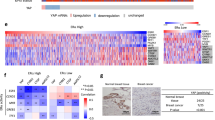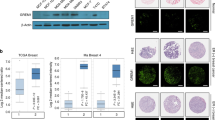Abstract
It is prevailingly thought that estrogen signaling is not involved in development of estrogen receptor (ER)-negative breast cancer. However, there is evidence indicating that ovariectomy prevents the development of both ER-positive and -negative breast cancer, suggesting that estrogen signaling is involved in the development of ER-negative breast cancer. Previously, our laboratory cloned a variant of ER-α, ER-α36, and found that ER-α36 mediated nongenomic estrogen signaling and is highly expressed in ER-negative breast cancer cells. In this study, we found that ER-α36 was highly expressed in 10/12 cases of triple-negative breast cancer. We investigated the role of mitogenic estrogen signaling mediated by ER-α36 in malignant growth of triple-negative breast cancer MDA-MB-231 and MDA-MB-436 cells that express high levels of ER-α36 and found that these cells strongly responded to mitogenic estrogen signaling both in vitro and in vivo. Knockdown of ER-α36 expression in these cells using the small hairpin RNA method diminished their responsiveness to estrogen. ER-α36 physically interacted with the EGFR/Src/Shc complex and mediated estrogen-induced phosphorylation of epidermal growth factor receptor (EGFR) and Src. EGFR signaling activated ER-α36 transcription through an AP1 site in the ER-α36 promoter, and ER-α36 expression was able to stabilize EGFR protein. Our results, thus demonstrated that ER-α36 mediates nongenomic estrogen signaling through the EGFR/Src/ERK signaling pathway in ER-negative breast cancer cells and suggested that a subset of ER-negative breast tumors that expresses ER-α36, retains responsiveness to mitogenic estrogen signaling.
This is a preview of subscription content, access via your institution
Access options
Subscribe to this journal
Receive 50 print issues and online access
$259.00 per year
only $5.18 per issue
Buy this article
- Purchase on Springer Link
- Instant access to full article PDF
Prices may be subject to local taxes which are calculated during checkout






Similar content being viewed by others
References
Behrens D, Gill JH, Fichtner I . (2007). Loss of tumourigenicity of stably ERβ-transfected MCF-7 breast cancer cells. Mole Cell Endocri 274: 19–29.
Biscardi JS, Maa MC, Tice DA, Cox ME, Leu TH, Parsons SJ . (1999). c-Src-mediated phosphorylation of the epidermal growth factor receptor on Tyr845 and Tyr1101 is associated with modulation of receptor function. J Biol Chem 274: 8335–8343.
Early Breast Cancer Trialists’ Collaborative Group (1992). Systemic treatment of early breast cancer by hormonal, cytotoxic, or immune therapy. 133 randomised trials involving 31 000 recurrences and 24 000 deaths among 75 000 women. Lancet 339: 1–15.
Friedl A, Gottardis MM, Pink J, Buchler DA, Jordan VC . (1989). Enhanced growth of an estrogen receptor-negative endometrial adenocarcinoma by estradiol in athymic mice. Cancer Res 49: 4758–4764.
Friedl A, Jordan VC . (1994). Oestradiol stimulates growth of oestrogen receptor-negative MDA-MB-231 breast cancer cells in immunodeficient mice by reducing cell loss. Eur J Cancer 30A: 1559–1564.
Geisler J, Haynes B, Anker G, Dowsett M, Lonning PE . (2002). Influence of letrozole and anastrozole on total body aromatization and plasma estrogen levels in postmenopausal breast cancer patients evaluated in a randomized, cross-over study. J Clin Oncol 20: 751–757.
Howell A, Osborne CK, Morris C, Wakeling AE . (2000). ICI 182 780 (Faslodex): development of a novel, ‘pure’ antiestrogen. Cancer 89: 817–825.
Kang L, Wang ZY . (2010). Breast cancer cell growth inhibition by phenethyl isothiocyanate is associated with downregulation of estrogen receptor-alpha36. J Cell Mol Med 14: 1485–1493.
Lacroix M, Toillon RA, Leclercq G . (2004). Stable ‘portrait’ of breast tumors during progression: data from biology, pathology and genetics. Endocr Relat Cancer 11: 497–522.
Lazennec G, Bresson D, Lucas A, Chauveau C, Vignon F . (2001). ERβ inhibits proliferation and invasion of breast cancer cells. Endocr 142: 4120–4130.
Lee LM, Cao J, Deng H, Chen P, Gatalica Z, Wang ZY . (2008). ER-alpha36, a novel variant of ER-alpha, is expressed in ER-positive and -negative human breast carcinomas. Anticancer Res 28: 479–483.
Lin SL, Yan LY, Zhang XT, Yuan J, Li M, Qiao J et al. (2010). ER-alpha36, a variant of ER-alpha, promotes tamoxifen agonist action in endometrial cancer cells via the MAPK/ERK and PI3K/Akt pathways. PLoS One 5: e9013.
Mahfoudi A, Roulet E, Dauvois S, Parker MG, Wahli W . (1995). Specific mutations in the estrogen receptor change the properties of antiestrogens to full agonists. Proc Natl Acad Sci USA 92: 4206–4210.
Narod SA . (2001). Hormonal prevention of hereditary breast cancer. Ann NY Acad Sci 952: 36–43.
Nissen-Meyer R . (1964). ‘Prophylactic’ ovariectomy and ovarian irradiation in breast cancer. Acta Unio Int Contra Cancrum 20: 527–530.
Rai D, Frolova A, Frasor J, Carpenter AE, Katzenellenbogen BS . (2005). Distinctive actions of membrane-targeted versus nuclear localized estrogen receptors in breast cancer cells. Mol Endocrinol 19: 1606–1617.
Rebbeck TR, Levin AM, Eisen A, Snyder C, Watson P, Cannon-Albright L et al. (1999). Breast cancer risk after bilateral prophylactic oophorectomy in BRCA1 mutation carriers. J Natl Cancer Inst 91: 1475–1479.
Shi L, Dong B, Li Z, Lu Y, Ouyang T, Li J et al. (2009). Expression of ER-{alpha}36, a novel variant of estrogen receptor {alpha}, and resistance to tamoxifen treatment in breast cancer. J Clin Oncol 27: 3423–3429.
Simpson PT, Reis-Filho JS, Gale T, Lakhani SR . (2005). Molecular evolution of breast cancer. J Pathol 205: 248–254.
Paruthiyil S, Parmar H, Kerekatte V, Cunha GR, Firestone GL, Leitman DC . (2004). Estrogen receptor β inhibits human breast cancer cell proliferation and tumor formation by causing a G2 cell cycle arrest. Cancer Res 64: 423–428.
Tong D, Schuster E, Seifert M, Czerwenka K, Leodolter S, Zeillinger R . (2002). Expression of estrogen receptor beta isoforms in human breast cancer tissues and cell lines. Breast Cancer Res and Treat 71: 249–255.
Tsai EM, Wang SC, Lee JN, Hung MC . (2001). Akt activation by estrogen in estrogen receptor-negative breast cancer cells. Cancer Res 61: 8390–8392.
Wang Z, Zhang X, Shen P, Loggie BW, Chang Y, Deuel TF . (2005). Identification, cloning, and expression of human estrogen receptor-alpha36, a novel variant of human estrogen receptor-alpha66. Biochem Biophys Res Commun 336: 1023–1027.
Wang Z, Zhang X, Shen P, Loggie BW, Chang Y, Deuel TF . (2006). A variant of estrogen receptor-{alpha}, hER-{alpha}36: transduction of estrogen- and antiestrogen-dependent membrane-initiated mitogenic signaling. Proc Natl Acad Sci USA 103: 9063–9068.
Wolff AC, Hammond ME, Schwartz JN, Hagerty KL, Allred DC, Cote RJ, et al., American Society of Clinical Oncology, College of American Pathologists. (2007). American Society of Clinical Oncology/College of American Pathologists guideline recommendations for human epidermal growth factor receptor 2 testing in breast cancer. J Clin Oncol 25: 118–145.
Zou Y, Ding L, Coleman M, Wang Z . (2009). Estrogen receptor-alpha (ER-alpha) suppresses expression of its variant ER-alpha 36. FEBS Lett 583: 1368–1374.
Acknowledgements
This work was supported by National Institute of Health Grant DK84328 and by the Nebraska Tobacco Settlement Biomedical Research Program Award (LB-595 and LB692) to ZY Wang. Dr Semir Vranic was a research fellow at Creighton University Medical School, Omaha, NE, USA and had been supported by a UICC American Cancer Society Beginning Investigators Fellowship (ACSBI) (ACS/08/004) funded by the American Cancer Society.
Author information
Authors and Affiliations
Corresponding author
Ethics declarations
Competing interests
The authors declare no conflict of interest.
Additional information
Supplementary Information accompanies the paper on the Oncogene website
Rights and permissions
About this article
Cite this article
Zhang, X., Kang, L., Ding, L. et al. A positive feedback loop of ER-α36/EGFR promotes malignant growth of ER-negative breast cancer cells. Oncogene 30, 770–780 (2011). https://doi.org/10.1038/onc.2010.458
Received:
Revised:
Accepted:
Published:
Issue Date:
DOI: https://doi.org/10.1038/onc.2010.458
Keywords
This article is cited by
-
Recent advances in therapeutic strategies for triple-negative breast cancer
Journal of Hematology & Oncology (2022)
-
Estrogen/ER in anti-tumor immunity regulation to tumor cell and tumor microenvironment
Cancer Cell International (2021)
-
Triple-negative breast cancer molecular subtyping and treatment progress
Breast Cancer Research (2020)
-
ER-α36 mediates cisplatin resistance in breast cancer cells through EGFR/HER-2/ERK signaling pathway
Journal of Experimental & Clinical Cancer Research (2018)
-
Concomitant high expression of ERα36, GRP78 and GRP94 is associated with aggressive papillary thyroid cancer behavior
Cellular Oncology (2018)



